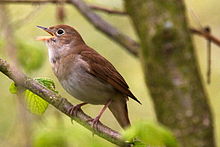Nightingale (Coleridge)
Nightingale – wiersz angielskiego poety romantycznego Samuela Taylora Coleridge’a, ogłoszony po raz pierwszy we wspólnym tomie Coleridge’e i Williama Wordswortha Ballady liryczne w 1798. Utwór był początkowo opatrzony podtytułem A Conversation Poem. Jest przykładem romantycznej liryki przyrody[1]. Został napisany wierszem białym[2] (blank verse), czyli nierymowanym pentametr jambiczny, powszechnie wykorzystywanym w literaturze angielskiej. Jako ornamentu bezrymowego toku wiersza poeta użył aliteracji, czyli współbrzmienia początkowego: Most musical, most melancholy; And he beheld the moon, and, hushed at once, Suspends his sobs, and laughs most silently.

- No cloud, no relique of the sunken day
- Distinguishes the West, no long thin slip
- Of sullen light, no obscure trembling hues.
- Come, we will rest on this old mossy bridge!
- You see the glimmer of the stream beneath,
- But hear no murmuring: it flows silently.
- O'er its soft bed of verdure. All is still.
- A balmy night! and though the stars be dim,
- Yet let us think upon the vernal showers
- That gladden the green earth, and we shall find
- A pleasure in the dimness of the stars.
Na język polski utwór przełożył Zygmunt Kubiak[3]. Zobacz: Rymy o starym marynarzu (poemat)
Przypisy
edytuj- ↑ The Nightingale by Coleridge: Analysis & Overview. study.com. [dostęp 2017-02-08]. (ang.).
- ↑ The Nightingale by Samuel Taylor Coleridge. shmoop.com. [dostęp 2017-02-08]. (ang.).
- ↑ Samuel Taylor Coleridge: Poezje wybrane. Wybrał, przełożył i wstępem opatrzył Zygmunt Kubiak. Państwowy Instytut Wydawniczy, 1987. ISBN 83-06-01468-5.
Bibliografia
edytuj- Susan Luther: "A Different Lore": Coleridge's "The Nightingale". jstor.org. [dostęp 2017-02-08]. (ang.).
Linki zewnętrzne
edytuj- Samuel Taylor Coleridge: The Nightingale. A Conversation Poem, April, 1798. online-literature.com. [dostęp 2017-02-08]. (ang.).